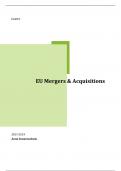College aantekeningen
Notes EU M&A (14/20)
- Instelling
- Universiteit Gent (UGent)
Those are complete notes for the EU M&A course that I did, based on the oral explanation and the power points. It is perfectly complete and contains all relevant information note: there might be some spelling faults
[Meer zien]



